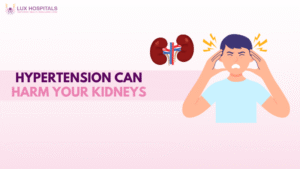Bladder Prolapse 101: How to Recognize, Treat, and Prevent This Common Condition at Lux Hospitals

At Lux Hospitals, we understand that health concerns such as bladder prolapse can significantly impact your quality of life. Bladder prolapse, also known as cystocele, is a condition where the bladder protrudes into the vaginal wall due to weakened pelvic support. This common issue affects many women, but with the right knowledge and treatment, it can be managed effectively. In this comprehensive guide, we’ll cover how to recognize bladder prolapse, explore the advanced bladder prolapse treatments available at Lux Hospitals, and offer tips for prevention.
What is Bladder Prolapse?
Bladder prolapse occurs when the bladder slips into the vaginal wall due to weakened pelvic floor muscles and connective tissues. This condition is a type of pelvic organ prolapse (POP) and can lead to various symptoms, including urinary issues and physical discomfort. At Lux Hospitals, our team specializes in diagnosing and treating bladder prolapse to help you regain comfort and control over your health.
Anatomy
To understand bladder prolapse, it’s crucial to know the anatomy of the pelvic floor. The pelvic floor comprises muscles and connective tissues that support the bladder, uterus, and rectum. When these structures become weakened, they can no longer hold the bladder in its proper position, leading to a prolapse.
Types of Prolapse:
- Cystocele (Bladder Prolapse): The bladder bulges into the front wall of the vagina.
- Rectocele: The rectum pokes through the vagina’s rear wall.
- Uterine Prolapse: The vaginal canal is where the uterus descends.
- Vaginal Vault Prolapse: The top of the vagina falls into the vaginal canal, often seen after a hysterectomy.
Recognizing Bladder Prolapse
Common Symptoms
Recognizing bladder prolapse early can prevent complications and improve treatment outcomes. Symptoms to watch for include:
- Urinary Symptoms: These may include urinary incontinence (leakage), frequent urination, and difficulty fully emptying the bladder.
- Physical Symptoms: A noticeable bulge or pressure in the vaginal area, which may worsen throughout the day or after physical activity.
- Sexual Symptoms: Discomfort or pain during sexual intercourse can also indicate bladder prolapse.
When to See a Doctor
If you experience these symptoms, it’s important to consult with a healthcare provider. At Lux Hospitals, we offer comprehensive evaluations to diagnose bladder prolapse accurately. Our expert team will conduct a thorough review of your symptoms, medical history, and perform necessary tests to determine the best course of action for bladder prolapse treatment.
Causes and Risk Factors
Primary Causes
Bladder prolapse can be caused by several factors:
- Weakened Pelvic Floor Muscles: frequently brought on by ageing, childbearing, or hormonal changes.
- Childbirth Complications: Difficult or prolonged labor can damage the pelvic support structures.
- Hormonal Changes: Menopause and decreased estrogen levels can weaken the pelvic tissues.
Risk Factors
Several factors can increase the risk of bladder prolapse:
- Age and Hormonal Changes: Women undergoing menopause or those who are older are at higher risk due to natural weakening of pelvic tissues.
- Obesity: Excess weight places additional pressure on the pelvic organs.
- Chronic Straining: Conditions such as chronic constipation or heavy lifting can strain the pelvic floor.
- Previous Pelvic Surgeries: Past surgeries affecting the pelvic area can also increase the risk of prolapse.

Diagnosis
Medical Evaluation
Accurate diagnosis is crucial for effective bladder prolapse treatment:
- Symptoms Review: Our specialists at Lux Hospitals will review your symptoms and medical history to understand the extent of your condition.
- Physical Examination: A pelvic exam helps assess the presence and severity of prolapse, determining how far the bladder has descended and its impact on surrounding tissues.
Diagnostic Tests
To confirm the diagnosis and plan the best bladder prolapse treatment, additional tests may be necessary:
- Urodynamic Studies: These tests measure bladder function, including capacity and how well it empties.
- Imaging Tests: Ultrasound or MRI provides detailed images of the pelvic structures, helping to assess the extent of the prolapse.
- Cystoscopy: This endoscopic procedure allows direct visualization of the bladder and urethra to check for abnormalities.
Treatment Options at Lux Hospitals
At Lux Hospitals, we offer a range of treatment options tailored to your specific needs:
Non-Surgical Treatments
Our non-surgical approaches are often the first line of treatment for bladder prolapse:
- Lifestyle Changes: We provide guidance on weight management and dietary adjustments to reduce pressure on the pelvic organs. Addressing constipation through dietary changes is also recommended.
- Pelvic Floor Exercises: Our experts offer personalized exercise plans, including Kegels, to strengthen the pelvic floor muscles and provide better support to the bladder and other pelvic organs.
- Pessaries: Lux Hospitals offers a variety of pessaries, devices inserted into the vagina to support the bladder and alleviate symptoms. Our team will help you choose the most appropriate pessary for your condition.
Surgical Treatments
Surgical options may be taken into consideration when non-surgical treatments are insufficient:
- Types of Surgery: Our surgical options include anterior repair (surgical repair of the vaginal wall) or implantation of a vaginal mesh to support the bladder. These procedures aim to restore the bladder to its proper position and improve symptoms.
- Recovery and Risks: Our team at Lux Hospitals provides detailed information about what to expect during recovery and potential risks associated with surgery, ensuring you are well-prepared.
Alternative Therapies
In addition to conventional treatments, we may offer alternative therapies:
- Physical Therapy: Specialized physical therapy approaches to strengthen the pelvic floor and improve function.
- Complementary Treatments: Techniques such as acupuncture or herbal remedies may be discussed as part of a comprehensive treatment plan.
Preventing Bladder Prolapse
Prevention is key to reducing the risk of bladder prolapse and managing symptoms effectively:
Pelvic Floor Health
Maintaining pelvic floor health is crucial:
- Regular Exercises: Incorporate pelvic floor exercises into your routine to strengthen the muscles and support pelvic organs.
- Proper Lifting Techniques: Learn and practice correct lifting techniques to avoid excessive strain on the pelvic floor.
Healthy Lifestyle Choices
Adopt healthy lifestyle choices to reduce risk:
- Maintaining a Healthy Weight: Reduces pressure on the pelvic organs and lowers the risk of prolapse.
- Managing Chronic Conditions: Address conditions like constipation that can cause chronic straining and stress on the pelvic floor.
Regular Check-ups
Routine medical check-ups are essential:
- Routine Exams: Regular gynecological and urological exams are crucial, especially if you are at risk. These exams help in early detection and timely intervention.
Living with Bladder Prolapse
Managing bladder prolapse involves both medical treatment and lifestyle adjustments:
Coping Strategies
Adjusting daily activities can improve quality of life:
- Managing Daily Activities: Make modifications to daily routines to accommodate symptoms and reduce discomfort. Using support devices like pessaries can also be beneficial.
- Support Resources: Access support groups and counseling options for emotional and practical support. Lux Hospitals provides resources and referrals to support your needs.
Long-Term Management
Ongoing care is vital for long-term management:
- Ongoing Care: Regular follow-ups with healthcare providers at Lux Hospitals help monitor the condition and adjust treatment as needed.
- Adapting to Changes: Maintaining a proactive approach to health and adapting to changes in symptoms or treatment plans is key to managing bladder prolapse effectively.
Conclusion
Bladder prolapse is a common condition that can significantly impact your quality of life. However, with early recognition, effective treatment, and preventive measures, you can manage symptoms and improve your overall well-being. At Lux Hospitals, we are dedicated to providing comprehensive care for bladder prolapse, offering advanced diagnostic tools, personalized treatment options, and support for prevention and management.
If you suspect you have bladder prolapse or need guidance on managing the condition, we encourage you to consult with our expert team. Share your experiences or questions in the comments and reach out to Lux Hospitals for personalized advice and support.




















